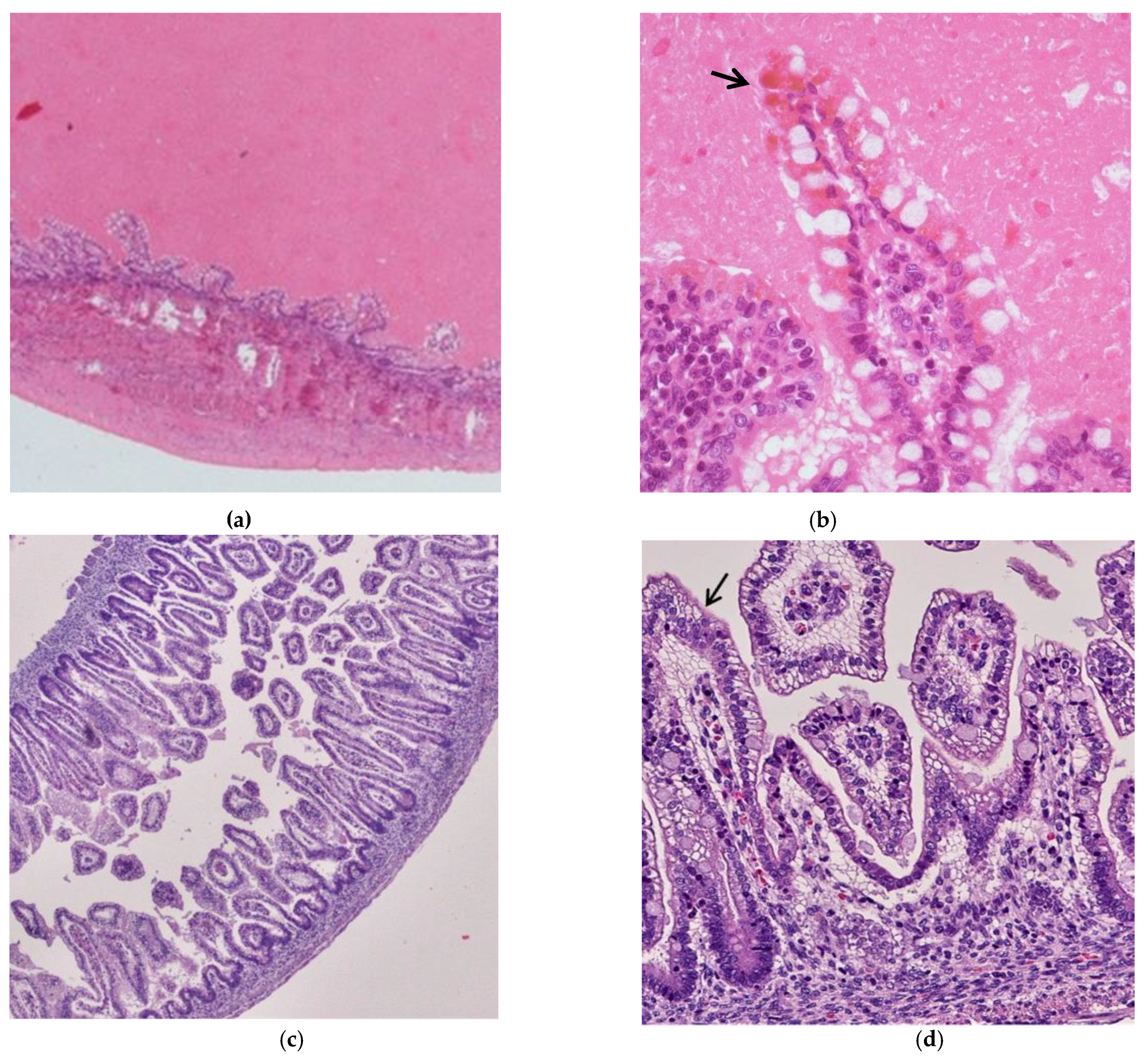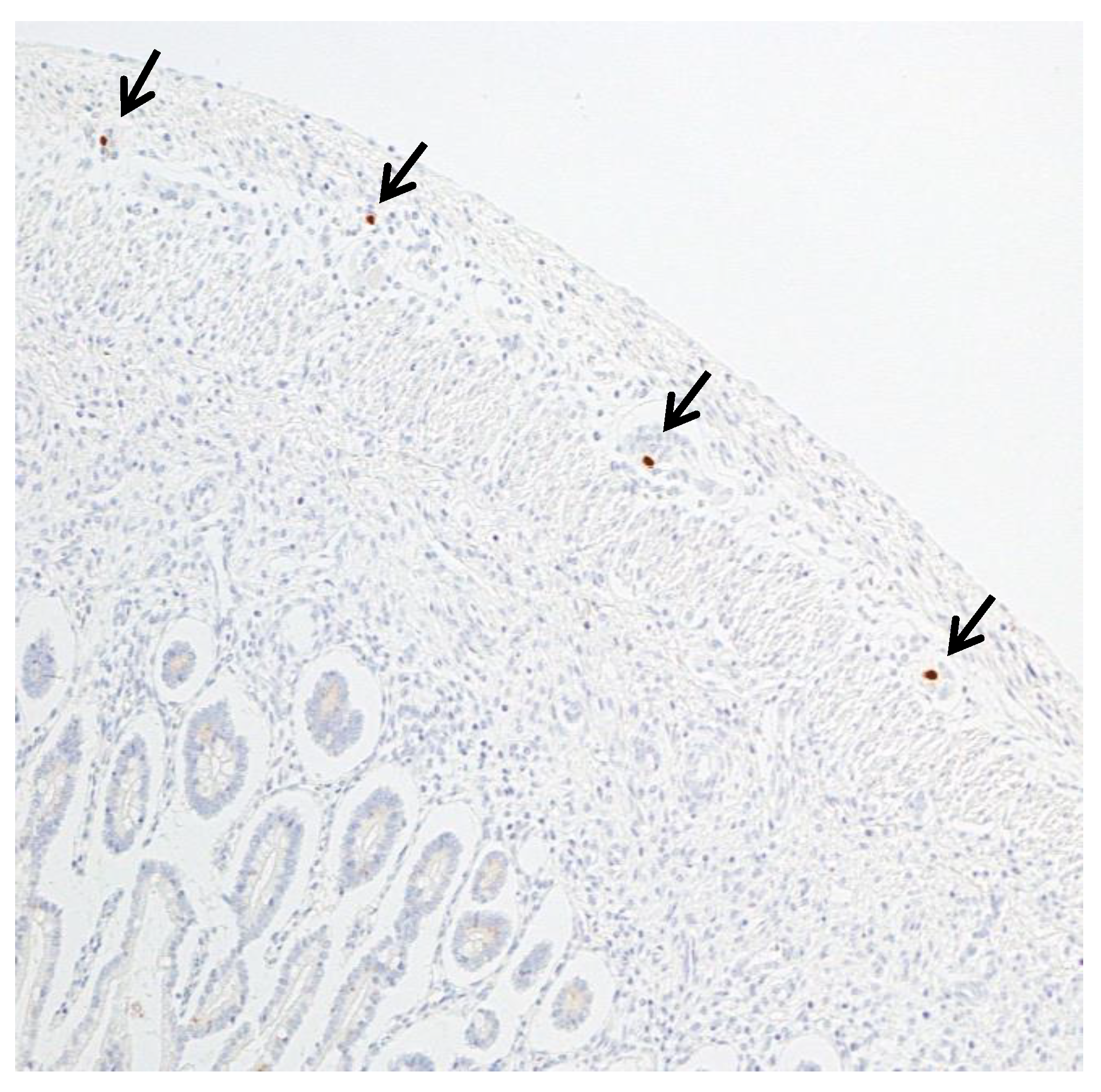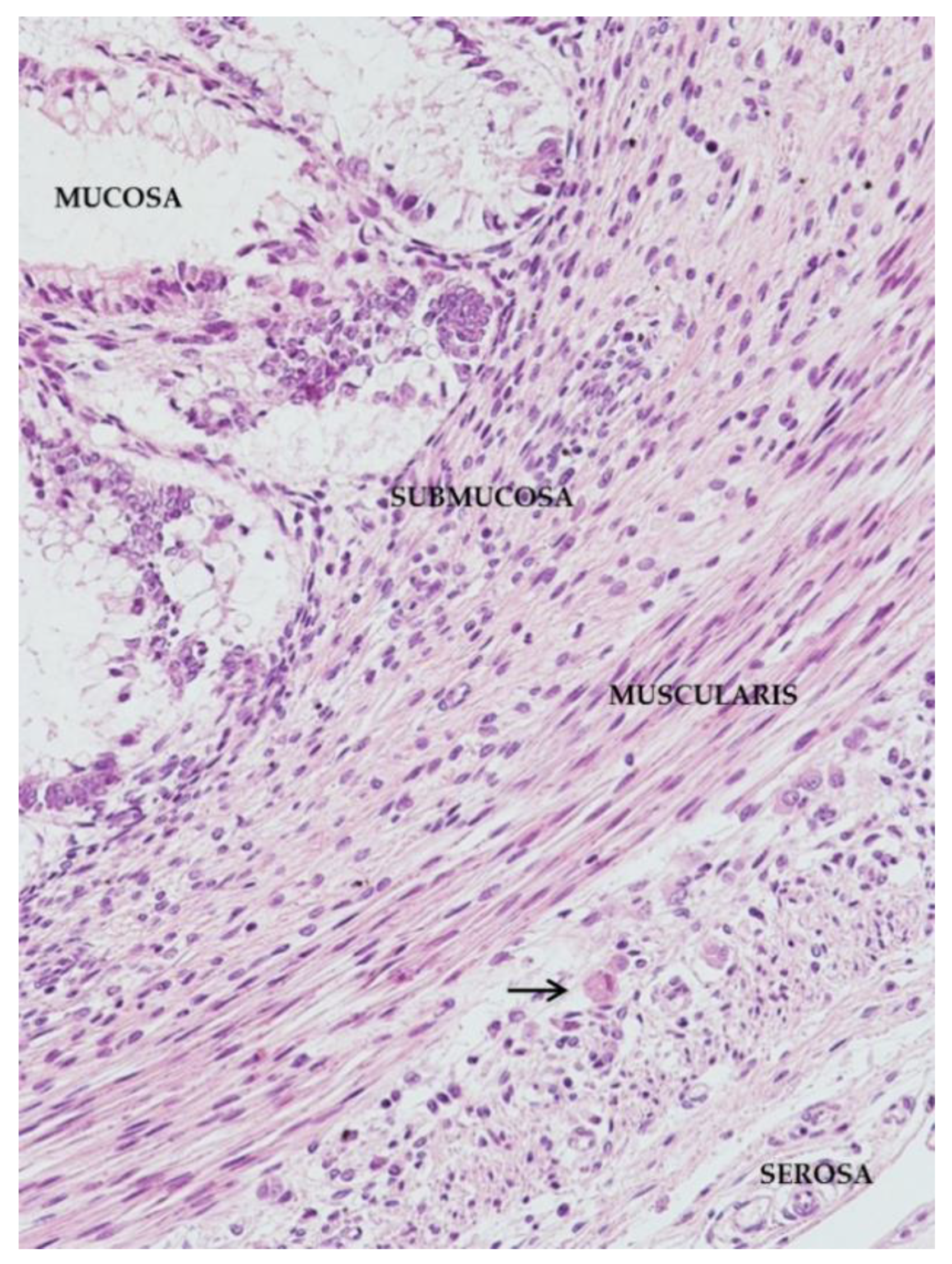Pathophysiology of Hyperechogenic Bowel in Congenitally Human Cytomegalovirus Infected Fetuses
Abstract
1. Introduction
2. Materials and Methods
2.1. Study Population
2.2. Histological Examination
2.3. Virological Examination
3. Results
3.1. CMV-Infected Fetuses with Prenatal Hyperechogenic Bowel at Ultrasound
3.2. CMV-Infected Fetuses with No Prenatal Hyperechogenic Bowel at Ultrasound
3.3. Negative Group
3.4. Summary
4. Discussion
5. Conclusions
Author Contributions
Funding
Acknowledgments
Conflicts of Interest
References
- Pass, R.F.; Arav-Boger, R. Maternal and fetal cytomegalovirus infection: Diagnosis, management, and prevention. F1000Research 2018, 7, 255. [Google Scholar] [CrossRef]
- Leruez-Ville, M.; Foulon, I.; Pass, R.; Ville, Y. Cytomegalovirus infection during pregnancy: State of the science. Am. J. Obstet. Gynecol. 2020. [Google Scholar] [CrossRef] [PubMed]
- Britt, W.J. Human cytomegalovirus infection in women with preexisting immunity: Sources of infection and mechanisms of infection in the presence of antiviral immunity. J. Infect. Dis. 2020, 221, S1–S8. [Google Scholar] [CrossRef] [PubMed]
- Lazzarotto, T.; Blázquez-Gamero, D.; Delforge, M.L.; Foulon, I.; Luck, S.; Modrow, S.; Leruez-Ville, M. Congenital cytomegalovirus infection: A narrative review of the issues in screening and management from a panel of european experts. Front. Pediatr. 2020, 8, 13. [Google Scholar] [CrossRef] [PubMed]
- Leruez-Ville, M.; Ville, Y. Fetal cytomegalovirus infection. Best. Pract. Res. Clin. Obstet. Gynaecol. 2017, 38, 97–107. [Google Scholar] [CrossRef] [PubMed]
- Kagan, K.O.; Hamprecht, K. Cytomegalovirus infection in pregnancy. Arch. Gynecol. Obstet. 2017, 296, 15–26. [Google Scholar] [CrossRef]
- D’Amico, A.; Buca, D.; Rizzo, G.; Khalil, A.; Silvi, C.; Makatsariya, A.; Nappi, L.; Liberati, M.; D’Antonio, F. Outcome of fetal echogenic bowel: A systematic review and meta-analysis. Prenat. Diagn. 2020. [Google Scholar] [CrossRef]
- Masini, G.; Maggio, L.; Marchi, L.; Cavalli, I.; Ledda, C.; Trotta, M.; Pasquini, L. Isolated fetal echogenic bowel in a retrospective cohort: The role of infection screening. Eur. J. Obstet. Gynecol. Reprod. Biol. 2018, 231, 136–141. [Google Scholar] [CrossRef]
- Goetzinger, K.R.; Cahill, A.G.; Macones, G.A.; Odibo, A.O. Echogenic bowel on second-trimester ultrasonography: Evaluating the risk of adverse pregnancy outcome. Obstet. Gynecol. 2011, 117, 1341–1348. [Google Scholar] [CrossRef]
- Catania, V.D.; Taddei, A.; Pellegrino, M.; De Marco, E.A.; Merli, L.; Manzoni, C.; Nanni, L.; Masini, L. Hyperechogenic bowel: Etiologies, management, and outcome according to gestational age at diagnosis in 279 consecutive cases in a single center. Eur. J. Pediatr. Surg. 2017, 27, 109–115. [Google Scholar] [CrossRef]
- Iruretagoyena, J.I.; Bankowsky, H.; Heiser, T.; Birkeland, L.; Grady, M.; Shah, D. Outcomes for fetal echogenic bowel during the second trimester ultrasound. J. Matern. Fetal. Neonatal. Med. 2010, 23, 1271–1273. [Google Scholar] [CrossRef] [PubMed]
- De Oronzo, M.A. Hyperechogenic fetal bowel: An ultrasonographic marker for adverse fetal and neonatal outcome? J. Prenat. Med. 2011, 5, 9–13. [Google Scholar] [PubMed]
- Jouannic, J.M.; Gavard, L.; Créquat, J.; Muller, F.; Serero, S.; Bénifla, J.L.; Costa, J.M. Isolated fetal hyperechogenic bowel associated with intra-uterine parvovirus B19 infection. Fetal. Diagn. Ther. 2005, 20, 498–500. [Google Scholar] [CrossRef] [PubMed]
- Déchelotte, P.J.; Mulliez, N.M.; Bouvier, R.J.; Vanlieféringhen, P.C.; Lémery, D.J. Pseudo-meconium ileus due to cytomegalovirus infection: A report of three cases. Pediatr. Pathol. 1992, 12, 73–82. [Google Scholar] [CrossRef] [PubMed]
- Nigro, G.; Adler, S.P.; Gatta, E.; Mascaretti, G.; Megaloikonomou, A.; La Torre, R.; Necozione, S. Fetal hyperechogenic bowel may indicate congenital cytomegalovirus disease responsive to immunoglobulin therapy. J. Matern. Fetal. Neonatal. Med. 2012, 25, 2202–2205. [Google Scholar] [CrossRef]
- Lazzarotto, T.; Guerra, B.; Lanari, M.; Gabrielli, L.; Landini, M.P. New advances in the diagnosis of congenital cytomegalovirus infection. J. Clin. Virol. 2008, 41, 192–197. [Google Scholar] [CrossRef]
- Lazzarotto, T.; Gabrielli, L.; Foschini, M.P.; Lanari, M.; Guerra, B.; Eusebi, V.; Landini, M.P. Congenital cytomegalovirus infection in twin pregnancies: Viral load in the amniotic fluid and pregnancy outcome. Pediatrics 2003, 112, e153–157. [Google Scholar] [CrossRef]
- Lazzarotto, T.; Guerra, B.; Gabrielli, L.; Lanari, M.; Landini, M.P. Update on the prevention, diagnosis and management of cytomegalovirus infection during pregnancy. Clin. Microbiol. Infect. 2011, 17, 1285–1293. [Google Scholar] [CrossRef]
- Guerra, B.; Simonazzi, G.; Puccetti, C.; Lanari, M.; Farina, A.; Lazzarotto, T.; Rizzo, N. Ultrasound prediction of symptomatic congenital cytomegalovirus infection. Am. J. Obstet. Gynecol. 2008, 198, 380, e1-7. [Google Scholar] [CrossRef]
- Gabrielli, L.; Bonasoni, M.P.; Lazzarotto, T.; Lega, S.; Santini, D.; Foschini, M.P.; Guerra, B.; Baccolini, F.; Piccirilli, G.; Chiereghin, A.; et al. Histological findings in foetuses congenitally infected by cytomegalovirus. J. Clin. Virol. 2009, 46, 16–21. [Google Scholar] [CrossRef]
- Gabrielli, L.; Bonasoni, M.P.; Santini, D.; Piccirilli, G.; Chiereghin, A.; Petrisli, E.; Dolcetti, R.; Guerra, B.; Piccioli, M.; Lanari, M.; et al. Congenital cytomegalovirus infection: Patterns of fetal brain damage. Clin. Microbiol. Infect. 2012, 18, e419–427. [Google Scholar] [CrossRef] [PubMed]
- Gabrielli, L.; Bonasoni, M.P.; Santini, D.; Piccirilli, G.; Chiereghin, A.; Guerra, B.; Landini, M.P.; Capretti, M.G.; Lanari, M.; Lazzarotto, T. Human fetal inner ear involvement in congenital cytomegalovirus infection. Acta Neuropathol. Commun. 2013, 1, 63. [Google Scholar] [CrossRef] [PubMed]
- Picone, O.; Teissier, N.; Cordier, A.G.; Vauloup-Fellous, C.; Adle-Biassette, H.; Martinovic, J.; Senat, M.V.; Ayoubi, J.M.; Benachi, A. Detailed in utero ultrasound description of 30 cases of congenital cytomegalovirus infection. Prenat. Diagn. 2014, 34, 518–524. [Google Scholar] [CrossRef] [PubMed]
- Mathias, C.R.; Joung, S.J.S. Diagnostic challenges in congenital cytomegalovirus infection in pregnancy: A case report. Case Rep. Womens Health 2019, 22, e00119. [Google Scholar] [CrossRef]
- Findley, R.; Allen, V.M.; Brock, J.K. Adverse Perinatal Conditions Associated With Prenatally Detected Fetal Echogenic Bowel in Nova Scotia. J. Obstet. Gynaecol. Can. 2018, 40, 555–560. [Google Scholar] [CrossRef] [PubMed]
- Odze, R.D.; Goldblum, J.R. Surgical Pathology of the GI Tract, Liver, Biliary Tract and Pancreas, 3rd ed.; Saunders: Philadelphia, PA, USA, 2015; pp. 148–168. [Google Scholar]
- Waldhausen, J.H.T.; Richards, M. Meconium ileus. Clin. Colon. Rectal. Surg. 2018, 31, 121–126. [Google Scholar] [CrossRef]
- Xue, R.; Gu, H.; Qiu, Y.; Guo, Y.; Korteweg, C.; Huang, J.; Gu, J. Expression of cystic fibrosis transmembrane conductance regulator in ganglia of human gastrointestinal tract. Sci. Rep. 2016, 6, 30926. [Google Scholar] [CrossRef]
- Wester, T.; Olsson, Y.; Olsen, L. Expression of bcl-2 in enteric neurons in normal human bowel and Hirschsprung disease. Arch. Pathol. Lab. Med. 1999, 123, 1264–1268. [Google Scholar]
- De Giorgio, R.; Sarnelli, G.; Corinaldesi, R.; Stanghellini, V. Advances in our understanding of the pathology of chronic intestinal pseudo-obstruction. Gut 2004, 53, 1549–1552. [Google Scholar] [CrossRef]
- Hennig, G.W.; Spencer, N.J.; Jokela-Willis, S.; Bayguinov, P.O.; Lee, H.T.; Ritchie, L.A.; Ward, S.M.; Smith, T.K.; Sanders, K.M. ICC-MY coordinate smooth muscle electrical and mechanical activity in the murine small intestine. Neurogastroenterol. Motil. 2010, 22, e138–151. [Google Scholar] [CrossRef][Green Version]
- Sanders, K.M.; Koh, S.D.; Ward, S.M. Interstitial cells of cajal as pacemakers in the gastrointestinal tract. Annu. Rev. Physiol. 2006, 68, 307–343. [Google Scholar] [CrossRef] [PubMed]
- Kito, Y. The functional role of intramuscular interstitial cells of Cajal in the stomach. J. Smooth Muscle Res. 2011, 47, 47–53. [Google Scholar] [CrossRef] [PubMed]
- Antonucci, A.; Fronzoni, L.; Cogliandro, L.; Cogliandro, R.F.; Caputo, C.; De Giorgio, R.; Pallotti, F.; Barbara, G.; Corinaldesi, R.; Stanghellini, V. Chronic intestinal pseudo-obstruction. World J. Gastroenterol. 2008, 14, 2953–2961. [Google Scholar] [CrossRef] [PubMed]
- Boppana, S.B.; Ross, S.A.; Fowler, K.B. Congenital cytomegalovirus infection: Clinical outcome. Clin. Infect. Dis. 2013, 57, S178–S181. [Google Scholar] [CrossRef]





| Case | Age (Years Old) | Diagnosis of Primary CMV Infection | Viral Load in AF at 21 WG (Copies/mL) | Cerebral US Abnormalities at 21 WG | Extracerebral US Abnormalities at 21 WG |
|---|---|---|---|---|---|
| 1 | 33 | CMV IgG seroconversion | >5.000.000 | microcephaly | HB |
| 2 | 20 | CMV IgM + CMV IgG + low avidity CMV IgG | 1.700.000 | periventricular hyperechogenicity | HB |
| 3 | 29 | CMV IgM + CMV IgG + low avidity CMV IgG | >5.000.000 | ventriculomegaly | HB |
| 4 | 37 | CMV IgM + CMV IgG + low avidity CMV IgG | 988.460 | - | HB |
| 5 | 34 | CMV IgM + CMV IgG + low avidity CMV IgG | 790.000 | periventricular hyperechogenicity | - |
| 6 | 31 | CMV IgG seroconversion | >5.000.000 | - | - |
| 7 | 32 | CMV IgG seroconversion | >5.000.000 | - | - |
| 8 | 22 | CMV IgM + CMV IgG + low avidity CMV IgG | 1.250.000 | - | - |
| Fetuses | Case | Macroscopic Findings | Bowel IHC CMV | Bowel IHC bcl-2 | Bowel IHC CD-117 | Pancreas IHC CFTR |
|---|---|---|---|---|---|---|
| CMV-infected with USHB | 1 | intestinal dilatation thickened meconium | ganglion cells (multiple in AP, scattered in MP) endothelial cells (scattered) | -/+ | + | + |
| 2 | thickened meconium | ganglion cells (multiple in AP, scattered in MP) endothelial cells (scattered) | -/+ | + | + | |
| 3 | intestinal dilatation thickened meconium | ganglion cells (multiple in AP, scattered in MP) endothelial cells (scattered) | -/+ | + | + | |
| 4 | thickened meconium | ganglion cells (multiple in AP, scattered in MP) endothelial cells (scattered) | -/+ | + | + | |
| CMV-infected without USHB | 5 | normal | ganglion cells (scattered in AP and MP) endothelial cells (scattered) | + | + | + |
| 6 | normal | ganglion cells (scattered in AP and MP) endothelial cells (scattered) | + | + | + | |
| 7 | normal | endothelial cells (scattered) | + | + | + | |
| 8 | normal | endothelial cells (scattered) | + | + | + | |
| Uninfected without USHB | 9 | normal | - | + | + | + |
| 10 | normal | - | + | + | + | |
| 11 | normal | - | + | + | + | |
| 12 | normal | - | + | + | + |
© 2020 by the authors. Licensee MDPI, Basel, Switzerland. This article is an open access article distributed under the terms and conditions of the Creative Commons Attribution (CC BY) license (http://creativecommons.org/licenses/by/4.0/).
Share and Cite
Gabrielli, L.; Bonasoni, M.P.; Chiereghin, A.; Piccirilli, G.; Borgatti, E.C.; Simonazzi, G.; Salfi, N.C.M.; Tamagnini, I.; Lazzarotto, T. Pathophysiology of Hyperechogenic Bowel in Congenitally Human Cytomegalovirus Infected Fetuses. Microorganisms 2020, 8, 779. https://doi.org/10.3390/microorganisms8050779
Gabrielli L, Bonasoni MP, Chiereghin A, Piccirilli G, Borgatti EC, Simonazzi G, Salfi NCM, Tamagnini I, Lazzarotto T. Pathophysiology of Hyperechogenic Bowel in Congenitally Human Cytomegalovirus Infected Fetuses. Microorganisms. 2020; 8(5):779. https://doi.org/10.3390/microorganisms8050779
Chicago/Turabian StyleGabrielli, Liliana, Maria P. Bonasoni, Angela Chiereghin, Giulia Piccirilli, Eva C. Borgatti, Giuliana Simonazzi, Nunzio C. M. Salfi, Ione Tamagnini, and Tiziana Lazzarotto. 2020. "Pathophysiology of Hyperechogenic Bowel in Congenitally Human Cytomegalovirus Infected Fetuses" Microorganisms 8, no. 5: 779. https://doi.org/10.3390/microorganisms8050779
APA StyleGabrielli, L., Bonasoni, M. P., Chiereghin, A., Piccirilli, G., Borgatti, E. C., Simonazzi, G., Salfi, N. C. M., Tamagnini, I., & Lazzarotto, T. (2020). Pathophysiology of Hyperechogenic Bowel in Congenitally Human Cytomegalovirus Infected Fetuses. Microorganisms, 8(5), 779. https://doi.org/10.3390/microorganisms8050779






